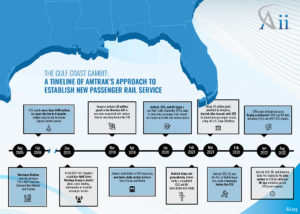The relationship between passenger rail and freight rail often comes across the way cinematic thrillers depict tension between the FBI and local police. Both want to ensure public safety and maintain order, but each wants to flex its jurisdiction and make sure it gets the respect it deserves. Like fictionalized law enforcement power plays, some level of tension does exist on the rails, even while there is also substantial cooperation taking place that does not make for good television.
Yet one real life example may end up containing enough intrigue for the silver screen. That is the battle in the Gulf Coast.
There, Amtrak is seeking to implement twice-daily service on a new route between Mobile, Alabama and New Orleans, Louisiana. The only problem is that the track is owned by CSX and Norfolk Southern, and Amtrak is seeking to add the new service without paying for the purported infrastructure improvements necessary to operate on the line without interrupting freight traffic.
While we are hopefully in the final act of a seven-year battle that could have been a straightforward process, here is a recap and explanation of how we got here.
All the way back in 2005, Hurricane Katrina barreled through the Gulf Coast and damaged hundreds of miles of railroad track owned and operated by freight railroads and used by Amtrak. Supply chains depended on reliable movement of freight, so the railroads went to work immediately spending private resources and insurance reimbursements to quickly restore and return the track to service. Within several months, freight trains were back on the tracks. Years went by before Amtrak even considered restoring passenger routes. And, when they did, the proposal was not like before.
In 2015, Congress was prodded to help advance passenger rail across the country and commissioned a working group to study and report on the potential for a Gulf Coast passenger route once more. The report in 2017 was friendly to Amtrak and identified numerous potential benefits for adding passenger service. The following year, Congress gifted Amtrak $5 million (in addition to its vast public support – which more recently included $66 billion in last year’s infrastructure bill) in funds for “costs associated with any matters Amtrak may elect to bring before the Surface Transportation Board related to passenger rail service.”
Less than a month later, Amtrak made a request of the freight carriers on the route to use the track for twice-daily service between Mobile and New Orleans. Under 49 U.S. Code § 24308, Amtrak is entitled to use the freight rail network and even receive preference over the operation of freight trains. The problem is that there still must be an agreement, otherwise the privately-funded freight infrastructure and business model may be disrupted by public-supported passenger service added and prioritized over moving goods.
The process began cooperatively, with a Rail Traffic Controller (RTC) study, which the rail industry uses to assess the impacts on current and projected train operations and to prioritize infrastructure investment to mitigate those impacts. Amtrak was participating in the study for over a year. However, Amtrak then withdrew before it was completed, and the additional resources Congress appropriated in the 2018 Omnibus served as the financial incentive it needed to make an end-run around negotiations by bringing it before the STB, hoping the federal regulator wouldn’t require the already fully taxpayer-funded passenger rail service to pay for projected infrastructure improvements.
No longer cooperative or requiring an agreement, the taxpayer owned and funded passenger corporation is hoping to obtain a government order to use the freight tracks without consideration to the impacts to present or future freight operations. That legal action launched over six months ago.
During the proceedings, Amtrak also achieved a victory from the STB by requiring CSX and NS railroads to reclassify “highly confidential” information to a lower level of confidentiality and the agency ordered the freight carriers that certain Amtrak personnel must be able to access their operational data.
In addition to longstanding subsidies and taxpayer resources, Amtrak has enjoyed several helping hands from the federal government as it relates to the Gulf Coast passenger plea. Congress helped provide research through a working group and an expense account for bringing issues to the STB. The ultimate disposition on the matter is yet to be known.
When it comes to Amtrak, the entity relies almost entirely on federal tax dollars and, as shown by countless reports from their own Inspector General, is plagued by fraud, mismanagement, and incompetence. Whether friendly federal efforts will help Amtrak across the finish line in this instance will soon be known. Then, we will see if this proves to be a working model for added service in other regions as well.
Written by Benjamin Dierker, Director of Public Policy
The Alliance for Innovation and Infrastructure (Aii) is an independent, national research and educational organization. An innovative think tank, Aii explores the intersection of economics, law, and public policy in the areas of climate, damage prevention, energy, infrastructure, innovation, technology, and transportation.
